An Analysis of Needle and Syringe Programs for HCV Prevention
VerifiedAdded on 2021/06/17
|17
|4982
|99
Essay
AI Summary
This essay explores the effectiveness of Needle and Syringe Programs (NSPs) in reducing the prevalence of Hepatitis C Virus (HCV) among people who inject drugs (PWID). The introduction establishes the high mortality and morbidity rates associated with drug use, particularly HCV, and highlights NSPs as a crucial harm reduction strategy. The essay delves into the epidemiology of HCV prevalence, especially among PWID in Australia, including the disproportionate impact on Indigenous populations. It examines the effects of HCV infections, such as hepatocellular carcinoma and cirrhosis, and provides a detailed overview of NSP services, including primary, secondary, and pharmacy-based programs. The analysis critically assesses the evidence for the effectiveness of NSPs in preventing HCV transmission, referencing various studies and meta-analyses with contradictory findings. While some studies suggest limited effectiveness, the essay acknowledges the potential benefits, such as cost-effectiveness and reduced HIV infection rates. The essay also discusses the importance of proper syringe disposal and the need for well-designed research to clarify the impact of NSPs on HCV prevention. Overall, the essay provides a comprehensive analysis of NSPs within the context of public health and harm reduction strategies.
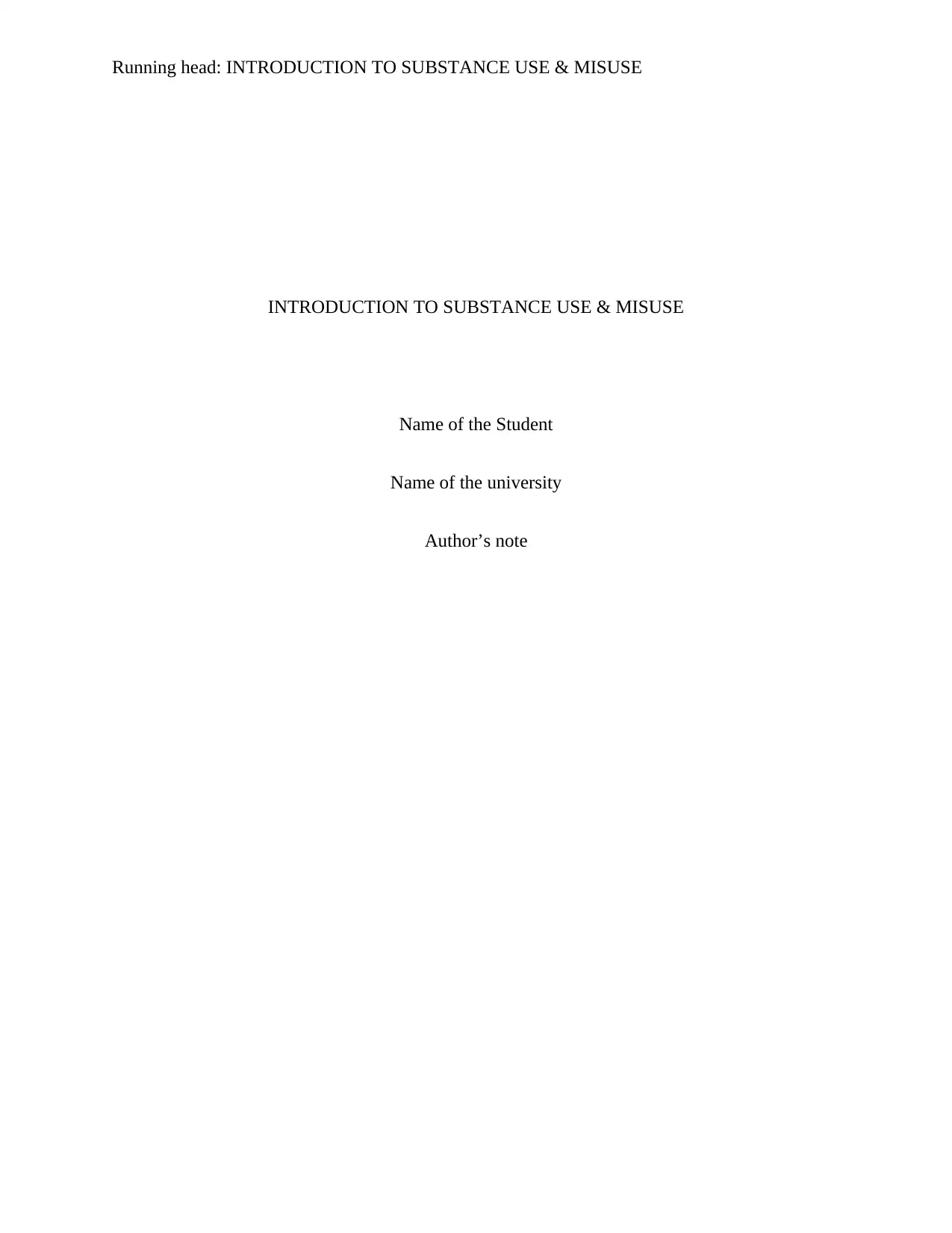
Running head: INTRODUCTION TO SUBSTANCE USE & MISUSE
INTRODUCTION TO SUBSTANCE USE & MISUSE
Name of the Student
Name of the university
Author’s note
INTRODUCTION TO SUBSTANCE USE & MISUSE
Name of the Student
Name of the university
Author’s note
Paraphrase This Document
Need a fresh take? Get an instant paraphrase of this document with our AI Paraphraser
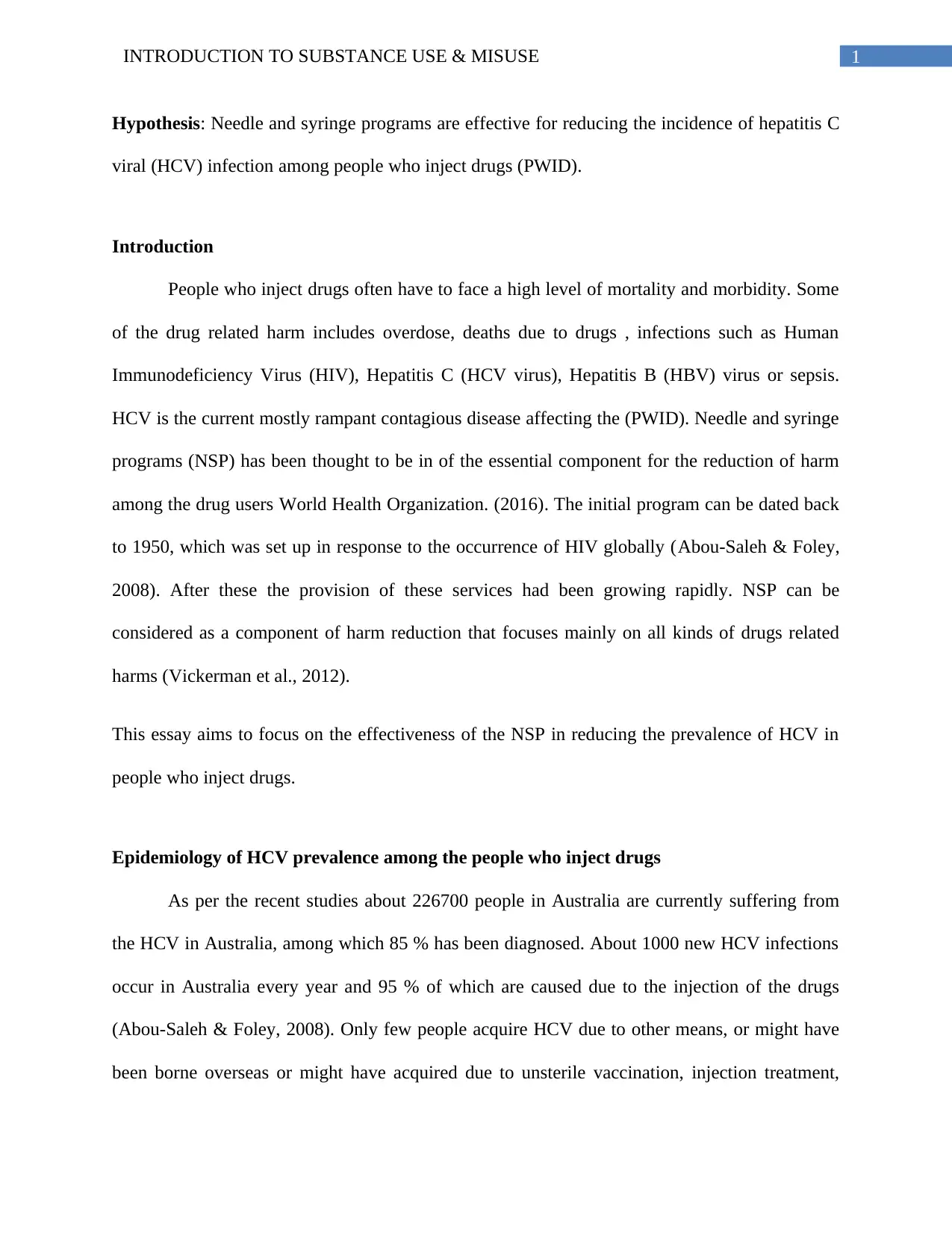
1INTRODUCTION TO SUBSTANCE USE & MISUSE
Hypothesis: Needle and syringe programs are effective for reducing the incidence of hepatitis C
viral (HCV) infection among people who inject drugs (PWID).
Introduction
People who inject drugs often have to face a high level of mortality and morbidity. Some
of the drug related harm includes overdose, deaths due to drugs , infections such as Human
Immunodeficiency Virus (HIV), Hepatitis C (HCV virus), Hepatitis B (HBV) virus or sepsis.
HCV is the current mostly rampant contagious disease affecting the (PWID). Needle and syringe
programs (NSP) has been thought to be in of the essential component for the reduction of harm
among the drug users World Health Organization. (2016). The initial program can be dated back
to 1950, which was set up in response to the occurrence of HIV globally (Abou-Saleh & Foley,
2008). After these the provision of these services had been growing rapidly. NSP can be
considered as a component of harm reduction that focuses mainly on all kinds of drugs related
harms (Vickerman et al., 2012).
This essay aims to focus on the effectiveness of the NSP in reducing the prevalence of HCV in
people who inject drugs.
Epidemiology of HCV prevalence among the people who inject drugs
As per the recent studies about 226700 people in Australia are currently suffering from
the HCV in Australia, among which 85 % has been diagnosed. About 1000 new HCV infections
occur in Australia every year and 95 % of which are caused due to the injection of the drugs
(Abou-Saleh & Foley, 2008). Only few people acquire HCV due to other means, or might have
been borne overseas or might have acquired due to unsterile vaccination, injection treatment,
Hypothesis: Needle and syringe programs are effective for reducing the incidence of hepatitis C
viral (HCV) infection among people who inject drugs (PWID).
Introduction
People who inject drugs often have to face a high level of mortality and morbidity. Some
of the drug related harm includes overdose, deaths due to drugs , infections such as Human
Immunodeficiency Virus (HIV), Hepatitis C (HCV virus), Hepatitis B (HBV) virus or sepsis.
HCV is the current mostly rampant contagious disease affecting the (PWID). Needle and syringe
programs (NSP) has been thought to be in of the essential component for the reduction of harm
among the drug users World Health Organization. (2016). The initial program can be dated back
to 1950, which was set up in response to the occurrence of HIV globally (Abou-Saleh & Foley,
2008). After these the provision of these services had been growing rapidly. NSP can be
considered as a component of harm reduction that focuses mainly on all kinds of drugs related
harms (Vickerman et al., 2012).
This essay aims to focus on the effectiveness of the NSP in reducing the prevalence of HCV in
people who inject drugs.
Epidemiology of HCV prevalence among the people who inject drugs
As per the recent studies about 226700 people in Australia are currently suffering from
the HCV in Australia, among which 85 % has been diagnosed. About 1000 new HCV infections
occur in Australia every year and 95 % of which are caused due to the injection of the drugs
(Abou-Saleh & Foley, 2008). Only few people acquire HCV due to other means, or might have
been borne overseas or might have acquired due to unsterile vaccination, injection treatment,
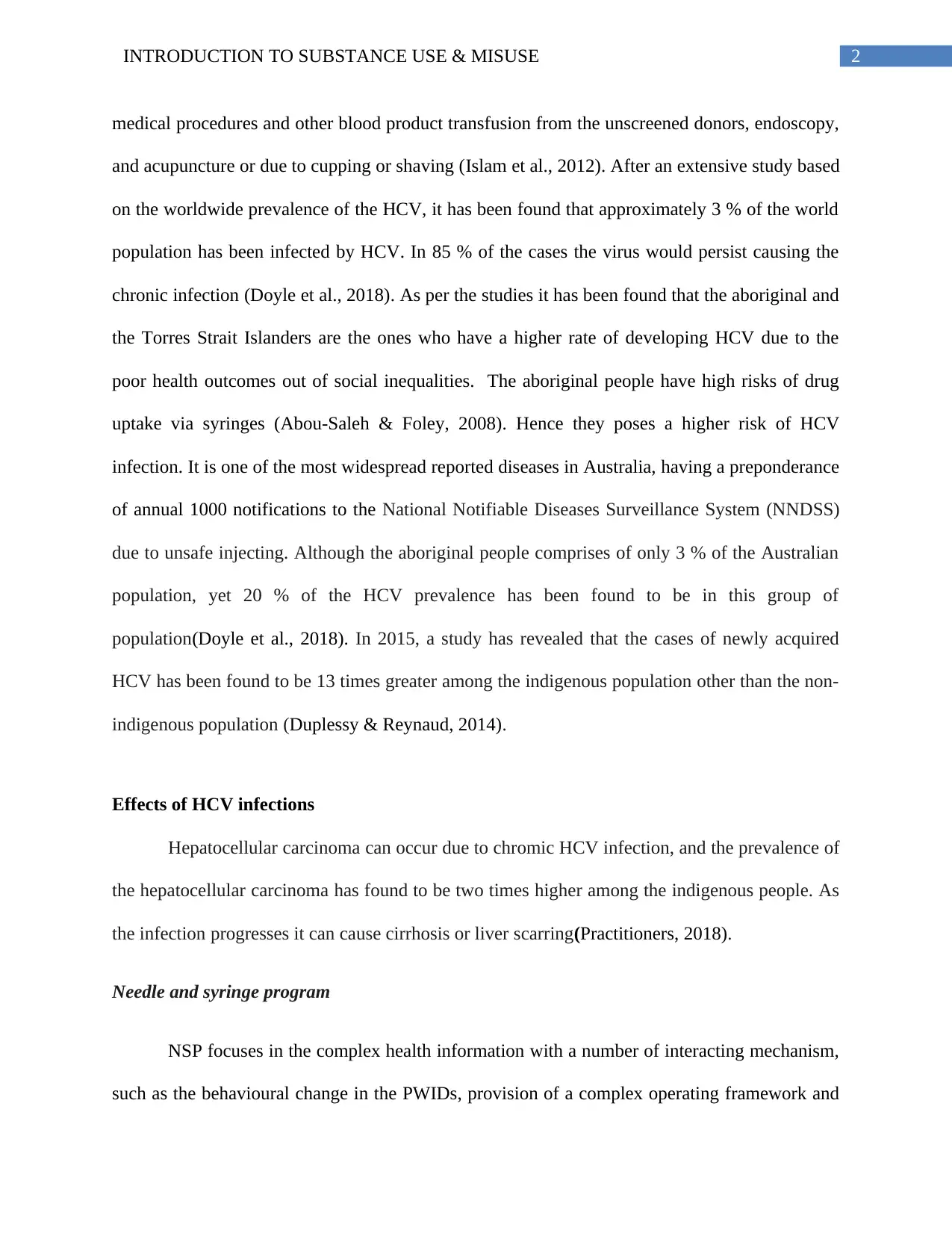
2INTRODUCTION TO SUBSTANCE USE & MISUSE
medical procedures and other blood product transfusion from the unscreened donors, endoscopy,
and acupuncture or due to cupping or shaving (Islam et al., 2012). After an extensive study based
on the worldwide prevalence of the HCV, it has been found that approximately 3 % of the world
population has been infected by HCV. In 85 % of the cases the virus would persist causing the
chronic infection (Doyle et al., 2018). As per the studies it has been found that the aboriginal and
the Torres Strait Islanders are the ones who have a higher rate of developing HCV due to the
poor health outcomes out of social inequalities. The aboriginal people have high risks of drug
uptake via syringes (Abou-Saleh & Foley, 2008). Hence they poses a higher risk of HCV
infection. It is one of the most widespread reported diseases in Australia, having a preponderance
of annual 1000 notifications to the National Notifiable Diseases Surveillance System (NNDSS)
due to unsafe injecting. Although the aboriginal people comprises of only 3 % of the Australian
population, yet 20 % of the HCV prevalence has been found to be in this group of
population(Doyle et al., 2018). In 2015, a study has revealed that the cases of newly acquired
HCV has been found to be 13 times greater among the indigenous population other than the non-
indigenous population (Duplessy & Reynaud, 2014).
Effects of HCV infections
Hepatocellular carcinoma can occur due to chromic HCV infection, and the prevalence of
the hepatocellular carcinoma has found to be two times higher among the indigenous people. As
the infection progresses it can cause cirrhosis or liver scarring(Practitioners, 2018).
Needle and syringe program
NSP focuses in the complex health information with a number of interacting mechanism,
such as the behavioural change in the PWIDs, provision of a complex operating framework and
medical procedures and other blood product transfusion from the unscreened donors, endoscopy,
and acupuncture or due to cupping or shaving (Islam et al., 2012). After an extensive study based
on the worldwide prevalence of the HCV, it has been found that approximately 3 % of the world
population has been infected by HCV. In 85 % of the cases the virus would persist causing the
chronic infection (Doyle et al., 2018). As per the studies it has been found that the aboriginal and
the Torres Strait Islanders are the ones who have a higher rate of developing HCV due to the
poor health outcomes out of social inequalities. The aboriginal people have high risks of drug
uptake via syringes (Abou-Saleh & Foley, 2008). Hence they poses a higher risk of HCV
infection. It is one of the most widespread reported diseases in Australia, having a preponderance
of annual 1000 notifications to the National Notifiable Diseases Surveillance System (NNDSS)
due to unsafe injecting. Although the aboriginal people comprises of only 3 % of the Australian
population, yet 20 % of the HCV prevalence has been found to be in this group of
population(Doyle et al., 2018). In 2015, a study has revealed that the cases of newly acquired
HCV has been found to be 13 times greater among the indigenous population other than the non-
indigenous population (Duplessy & Reynaud, 2014).
Effects of HCV infections
Hepatocellular carcinoma can occur due to chromic HCV infection, and the prevalence of
the hepatocellular carcinoma has found to be two times higher among the indigenous people. As
the infection progresses it can cause cirrhosis or liver scarring(Practitioners, 2018).
Needle and syringe program
NSP focuses in the complex health information with a number of interacting mechanism,
such as the behavioural change in the PWIDs, provision of a complex operating framework and
⊘ This is a preview!⊘
Do you want full access?
Subscribe today to unlock all pages.

Trusted by 1+ million students worldwide
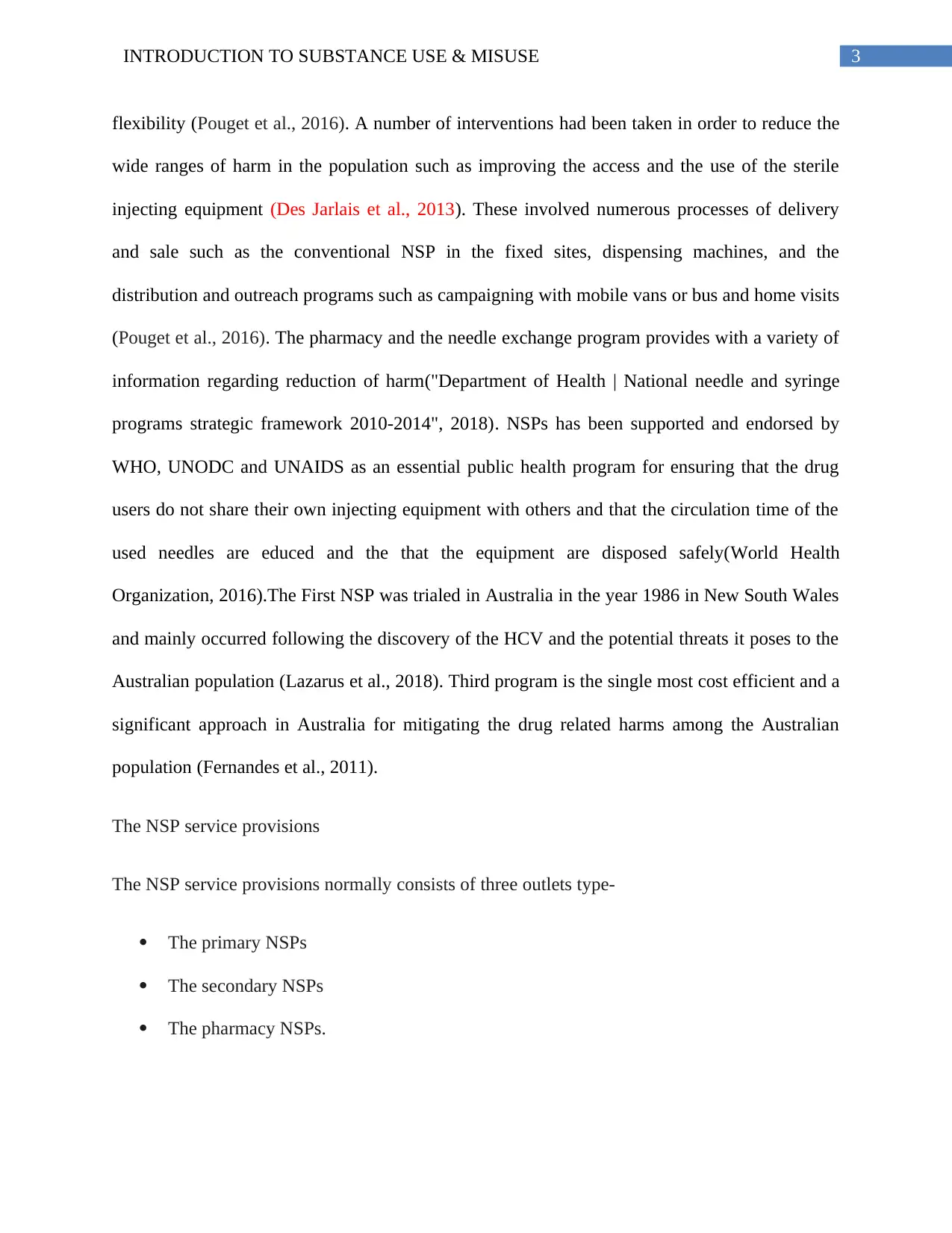
3INTRODUCTION TO SUBSTANCE USE & MISUSE
flexibility (Pouget et al., 2016). A number of interventions had been taken in order to reduce the
wide ranges of harm in the population such as improving the access and the use of the sterile
injecting equipment (Des Jarlais et al., 2013). These involved numerous processes of delivery
and sale such as the conventional NSP in the fixed sites, dispensing machines, and the
distribution and outreach programs such as campaigning with mobile vans or bus and home visits
(Pouget et al., 2016). The pharmacy and the needle exchange program provides with a variety of
information regarding reduction of harm("Department of Health | National needle and syringe
programs strategic framework 2010-2014", 2018). NSPs has been supported and endorsed by
WHO, UNODC and UNAIDS as an essential public health program for ensuring that the drug
users do not share their own injecting equipment with others and that the circulation time of the
used needles are educed and the that the equipment are disposed safely(World Health
Organization, 2016).The First NSP was trialed in Australia in the year 1986 in New South Wales
and mainly occurred following the discovery of the HCV and the potential threats it poses to the
Australian population (Lazarus et al., 2018). Third program is the single most cost efficient and a
significant approach in Australia for mitigating the drug related harms among the Australian
population (Fernandes et al., 2011).
The NSP service provisions
The NSP service provisions normally consists of three outlets type-
The primary NSPs
The secondary NSPs
The pharmacy NSPs.
flexibility (Pouget et al., 2016). A number of interventions had been taken in order to reduce the
wide ranges of harm in the population such as improving the access and the use of the sterile
injecting equipment (Des Jarlais et al., 2013). These involved numerous processes of delivery
and sale such as the conventional NSP in the fixed sites, dispensing machines, and the
distribution and outreach programs such as campaigning with mobile vans or bus and home visits
(Pouget et al., 2016). The pharmacy and the needle exchange program provides with a variety of
information regarding reduction of harm("Department of Health | National needle and syringe
programs strategic framework 2010-2014", 2018). NSPs has been supported and endorsed by
WHO, UNODC and UNAIDS as an essential public health program for ensuring that the drug
users do not share their own injecting equipment with others and that the circulation time of the
used needles are educed and the that the equipment are disposed safely(World Health
Organization, 2016).The First NSP was trialed in Australia in the year 1986 in New South Wales
and mainly occurred following the discovery of the HCV and the potential threats it poses to the
Australian population (Lazarus et al., 2018). Third program is the single most cost efficient and a
significant approach in Australia for mitigating the drug related harms among the Australian
population (Fernandes et al., 2011).
The NSP service provisions
The NSP service provisions normally consists of three outlets type-
The primary NSPs
The secondary NSPs
The pharmacy NSPs.
Paraphrase This Document
Need a fresh take? Get an instant paraphrase of this document with our AI Paraphraser
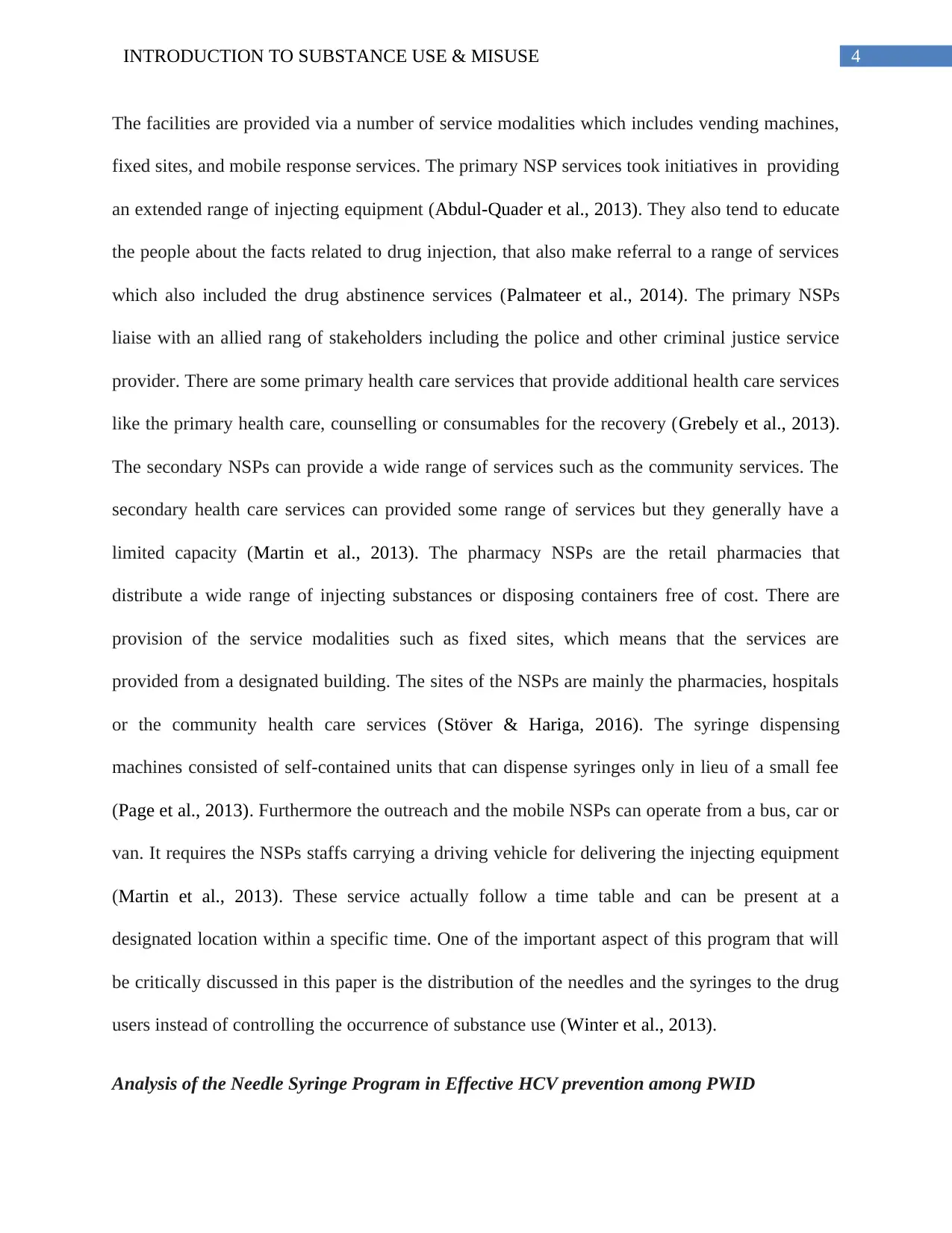
4INTRODUCTION TO SUBSTANCE USE & MISUSE
The facilities are provided via a number of service modalities which includes vending machines,
fixed sites, and mobile response services. The primary NSP services took initiatives in providing
an extended range of injecting equipment (Abdul-Quader et al., 2013). They also tend to educate
the people about the facts related to drug injection, that also make referral to a range of services
which also included the drug abstinence services (Palmateer et al., 2014). The primary NSPs
liaise with an allied rang of stakeholders including the police and other criminal justice service
provider. There are some primary health care services that provide additional health care services
like the primary health care, counselling or consumables for the recovery (Grebely et al., 2013).
The secondary NSPs can provide a wide range of services such as the community services. The
secondary health care services can provided some range of services but they generally have a
limited capacity (Martin et al., 2013). The pharmacy NSPs are the retail pharmacies that
distribute a wide range of injecting substances or disposing containers free of cost. There are
provision of the service modalities such as fixed sites, which means that the services are
provided from a designated building. The sites of the NSPs are mainly the pharmacies, hospitals
or the community health care services (Stöver & Hariga, 2016). The syringe dispensing
machines consisted of self-contained units that can dispense syringes only in lieu of a small fee
(Page et al., 2013). Furthermore the outreach and the mobile NSPs can operate from a bus, car or
van. It requires the NSPs staffs carrying a driving vehicle for delivering the injecting equipment
(Martin et al., 2013). These service actually follow a time table and can be present at a
designated location within a specific time. One of the important aspect of this program that will
be critically discussed in this paper is the distribution of the needles and the syringes to the drug
users instead of controlling the occurrence of substance use (Winter et al., 2013).
Analysis of the Needle Syringe Program in Effective HCV prevention among PWID
The facilities are provided via a number of service modalities which includes vending machines,
fixed sites, and mobile response services. The primary NSP services took initiatives in providing
an extended range of injecting equipment (Abdul-Quader et al., 2013). They also tend to educate
the people about the facts related to drug injection, that also make referral to a range of services
which also included the drug abstinence services (Palmateer et al., 2014). The primary NSPs
liaise with an allied rang of stakeholders including the police and other criminal justice service
provider. There are some primary health care services that provide additional health care services
like the primary health care, counselling or consumables for the recovery (Grebely et al., 2013).
The secondary NSPs can provide a wide range of services such as the community services. The
secondary health care services can provided some range of services but they generally have a
limited capacity (Martin et al., 2013). The pharmacy NSPs are the retail pharmacies that
distribute a wide range of injecting substances or disposing containers free of cost. There are
provision of the service modalities such as fixed sites, which means that the services are
provided from a designated building. The sites of the NSPs are mainly the pharmacies, hospitals
or the community health care services (Stöver & Hariga, 2016). The syringe dispensing
machines consisted of self-contained units that can dispense syringes only in lieu of a small fee
(Page et al., 2013). Furthermore the outreach and the mobile NSPs can operate from a bus, car or
van. It requires the NSPs staffs carrying a driving vehicle for delivering the injecting equipment
(Martin et al., 2013). These service actually follow a time table and can be present at a
designated location within a specific time. One of the important aspect of this program that will
be critically discussed in this paper is the distribution of the needles and the syringes to the drug
users instead of controlling the occurrence of substance use (Winter et al., 2013).
Analysis of the Needle Syringe Program in Effective HCV prevention among PWID
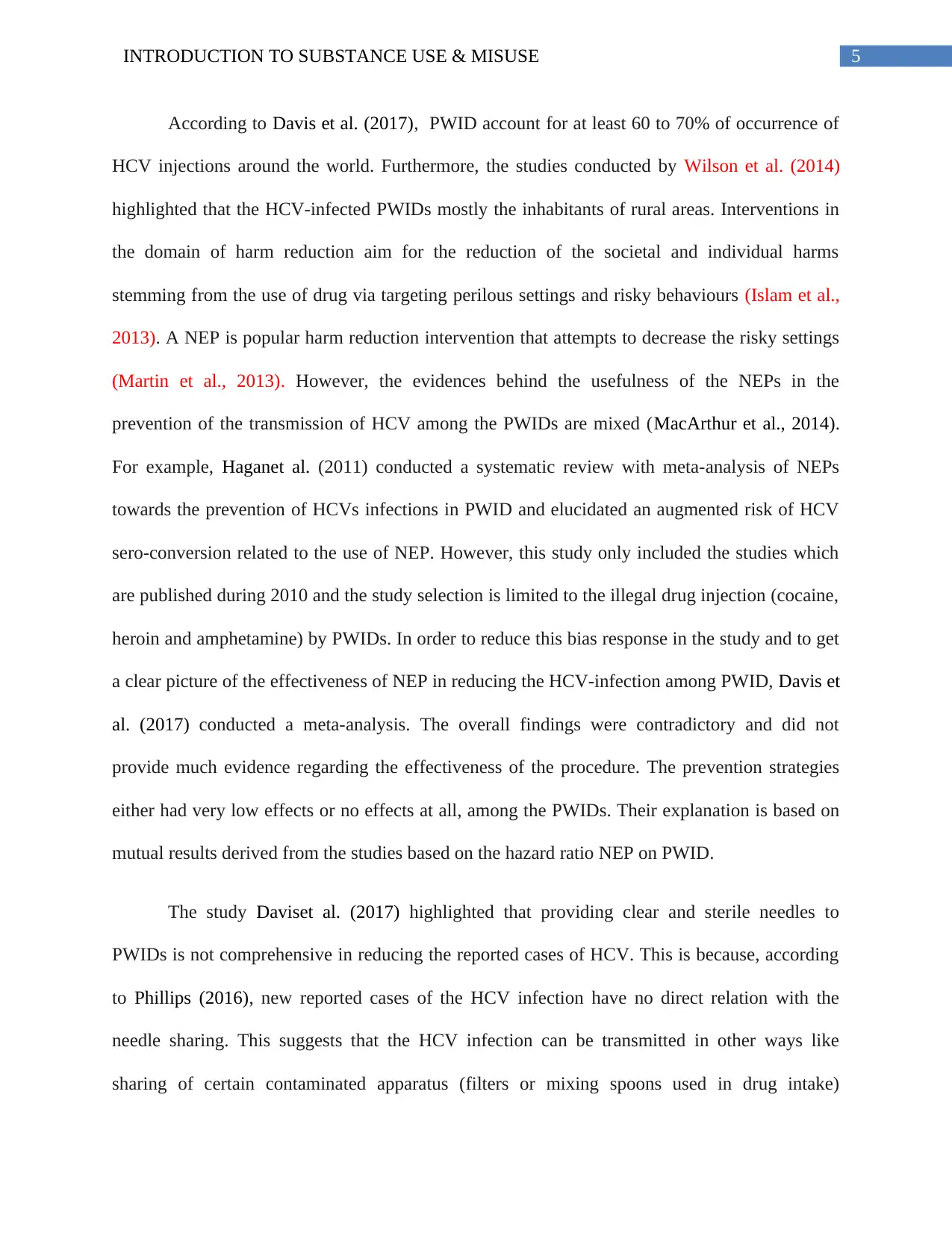
5INTRODUCTION TO SUBSTANCE USE & MISUSE
According to Davis et al. (2017), PWID account for at least 60 to 70% of occurrence of
HCV injections around the world. Furthermore, the studies conducted by Wilson et al. (2014)
highlighted that the HCV-infected PWIDs mostly the inhabitants of rural areas. Interventions in
the domain of harm reduction aim for the reduction of the societal and individual harms
stemming from the use of drug via targeting perilous settings and risky behaviours (Islam et al.,
2013). A NEP is popular harm reduction intervention that attempts to decrease the risky settings
(Martin et al., 2013). However, the evidences behind the usefulness of the NEPs in the
prevention of the transmission of HCV among the PWIDs are mixed (MacArthur et al., 2014).
For example, Haganet al. (2011) conducted a systematic review with meta-analysis of NEPs
towards the prevention of HCVs infections in PWID and elucidated an augmented risk of HCV
sero-conversion related to the use of NEP. However, this study only included the studies which
are published during 2010 and the study selection is limited to the illegal drug injection (cocaine,
heroin and amphetamine) by PWIDs. In order to reduce this bias response in the study and to get
a clear picture of the effectiveness of NEP in reducing the HCV-infection among PWID, Davis et
al. (2017) conducted a meta-analysis. The overall findings were contradictory and did not
provide much evidence regarding the effectiveness of the procedure. The prevention strategies
either had very low effects or no effects at all, among the PWIDs. Their explanation is based on
mutual results derived from the studies based on the hazard ratio NEP on PWID.
The study Daviset al. (2017) highlighted that providing clear and sterile needles to
PWIDs is not comprehensive in reducing the reported cases of HCV. This is because, according
to Phillips (2016), new reported cases of the HCV infection have no direct relation with the
needle sharing. This suggests that the HCV infection can be transmitted in other ways like
sharing of certain contaminated apparatus (filters or mixing spoons used in drug intake)
According to Davis et al. (2017), PWID account for at least 60 to 70% of occurrence of
HCV injections around the world. Furthermore, the studies conducted by Wilson et al. (2014)
highlighted that the HCV-infected PWIDs mostly the inhabitants of rural areas. Interventions in
the domain of harm reduction aim for the reduction of the societal and individual harms
stemming from the use of drug via targeting perilous settings and risky behaviours (Islam et al.,
2013). A NEP is popular harm reduction intervention that attempts to decrease the risky settings
(Martin et al., 2013). However, the evidences behind the usefulness of the NEPs in the
prevention of the transmission of HCV among the PWIDs are mixed (MacArthur et al., 2014).
For example, Haganet al. (2011) conducted a systematic review with meta-analysis of NEPs
towards the prevention of HCVs infections in PWID and elucidated an augmented risk of HCV
sero-conversion related to the use of NEP. However, this study only included the studies which
are published during 2010 and the study selection is limited to the illegal drug injection (cocaine,
heroin and amphetamine) by PWIDs. In order to reduce this bias response in the study and to get
a clear picture of the effectiveness of NEP in reducing the HCV-infection among PWID, Davis et
al. (2017) conducted a meta-analysis. The overall findings were contradictory and did not
provide much evidence regarding the effectiveness of the procedure. The prevention strategies
either had very low effects or no effects at all, among the PWIDs. Their explanation is based on
mutual results derived from the studies based on the hazard ratio NEP on PWID.
The study Daviset al. (2017) highlighted that providing clear and sterile needles to
PWIDs is not comprehensive in reducing the reported cases of HCV. This is because, according
to Phillips (2016), new reported cases of the HCV infection have no direct relation with the
needle sharing. This suggests that the HCV infection can be transmitted in other ways like
sharing of certain contaminated apparatus (filters or mixing spoons used in drug intake)
⊘ This is a preview!⊘
Do you want full access?
Subscribe today to unlock all pages.

Trusted by 1+ million students worldwide
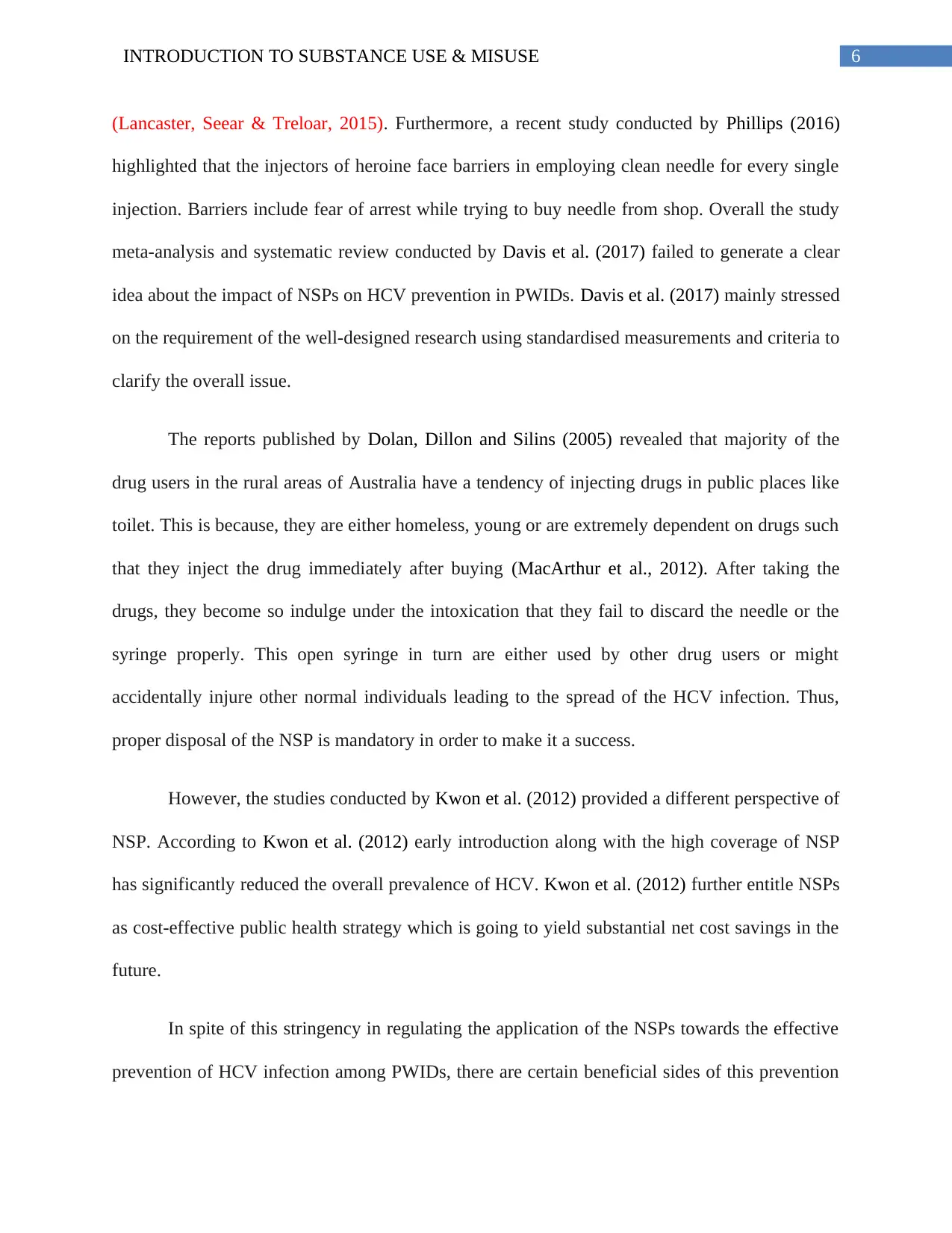
6INTRODUCTION TO SUBSTANCE USE & MISUSE
(Lancaster, Seear & Treloar, 2015). Furthermore, a recent study conducted by Phillips (2016)
highlighted that the injectors of heroine face barriers in employing clean needle for every single
injection. Barriers include fear of arrest while trying to buy needle from shop. Overall the study
meta-analysis and systematic review conducted by Davis et al. (2017) failed to generate a clear
idea about the impact of NSPs on HCV prevention in PWIDs. Davis et al. (2017) mainly stressed
on the requirement of the well-designed research using standardised measurements and criteria to
clarify the overall issue.
The reports published by Dolan, Dillon and Silins (2005) revealed that majority of the
drug users in the rural areas of Australia have a tendency of injecting drugs in public places like
toilet. This is because, they are either homeless, young or are extremely dependent on drugs such
that they inject the drug immediately after buying (MacArthur et al., 2012). After taking the
drugs, they become so indulge under the intoxication that they fail to discard the needle or the
syringe properly. This open syringe in turn are either used by other drug users or might
accidentally injure other normal individuals leading to the spread of the HCV infection. Thus,
proper disposal of the NSP is mandatory in order to make it a success.
However, the studies conducted by Kwon et al. (2012) provided a different perspective of
NSP. According to Kwon et al. (2012) early introduction along with the high coverage of NSP
has significantly reduced the overall prevalence of HCV. Kwon et al. (2012) further entitle NSPs
as cost-effective public health strategy which is going to yield substantial net cost savings in the
future.
In spite of this stringency in regulating the application of the NSPs towards the effective
prevention of HCV infection among PWIDs, there are certain beneficial sides of this prevention
(Lancaster, Seear & Treloar, 2015). Furthermore, a recent study conducted by Phillips (2016)
highlighted that the injectors of heroine face barriers in employing clean needle for every single
injection. Barriers include fear of arrest while trying to buy needle from shop. Overall the study
meta-analysis and systematic review conducted by Davis et al. (2017) failed to generate a clear
idea about the impact of NSPs on HCV prevention in PWIDs. Davis et al. (2017) mainly stressed
on the requirement of the well-designed research using standardised measurements and criteria to
clarify the overall issue.
The reports published by Dolan, Dillon and Silins (2005) revealed that majority of the
drug users in the rural areas of Australia have a tendency of injecting drugs in public places like
toilet. This is because, they are either homeless, young or are extremely dependent on drugs such
that they inject the drug immediately after buying (MacArthur et al., 2012). After taking the
drugs, they become so indulge under the intoxication that they fail to discard the needle or the
syringe properly. This open syringe in turn are either used by other drug users or might
accidentally injure other normal individuals leading to the spread of the HCV infection. Thus,
proper disposal of the NSP is mandatory in order to make it a success.
However, the studies conducted by Kwon et al. (2012) provided a different perspective of
NSP. According to Kwon et al. (2012) early introduction along with the high coverage of NSP
has significantly reduced the overall prevalence of HCV. Kwon et al. (2012) further entitle NSPs
as cost-effective public health strategy which is going to yield substantial net cost savings in the
future.
In spite of this stringency in regulating the application of the NSPs towards the effective
prevention of HCV infection among PWIDs, there are certain beneficial sides of this prevention
Paraphrase This Document
Need a fresh take? Get an instant paraphrase of this document with our AI Paraphraser
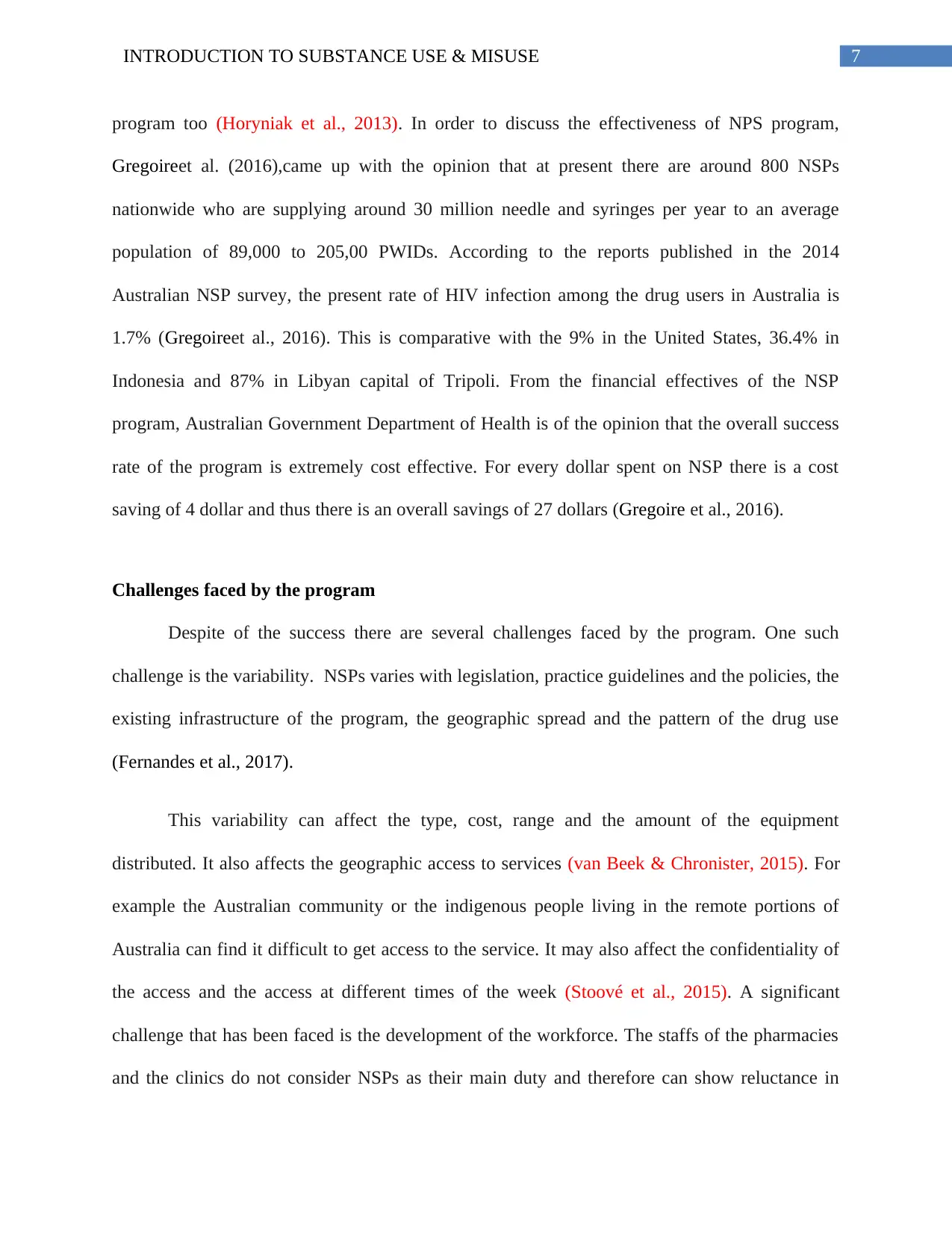
7INTRODUCTION TO SUBSTANCE USE & MISUSE
program too (Horyniak et al., 2013). In order to discuss the effectiveness of NPS program,
Gregoireet al. (2016),came up with the opinion that at present there are around 800 NSPs
nationwide who are supplying around 30 million needle and syringes per year to an average
population of 89,000 to 205,00 PWIDs. According to the reports published in the 2014
Australian NSP survey, the present rate of HIV infection among the drug users in Australia is
1.7% (Gregoireet al., 2016). This is comparative with the 9% in the United States, 36.4% in
Indonesia and 87% in Libyan capital of Tripoli. From the financial effectives of the NSP
program, Australian Government Department of Health is of the opinion that the overall success
rate of the program is extremely cost effective. For every dollar spent on NSP there is a cost
saving of 4 dollar and thus there is an overall savings of 27 dollars (Gregoire et al., 2016).
Challenges faced by the program
Despite of the success there are several challenges faced by the program. One such
challenge is the variability. NSPs varies with legislation, practice guidelines and the policies, the
existing infrastructure of the program, the geographic spread and the pattern of the drug use
(Fernandes et al., 2017).
This variability can affect the type, cost, range and the amount of the equipment
distributed. It also affects the geographic access to services (van Beek & Chronister, 2015). For
example the Australian community or the indigenous people living in the remote portions of
Australia can find it difficult to get access to the service. It may also affect the confidentiality of
the access and the access at different times of the week (Stoové et al., 2015). A significant
challenge that has been faced is the development of the workforce. The staffs of the pharmacies
and the clinics do not consider NSPs as their main duty and therefore can show reluctance in
program too (Horyniak et al., 2013). In order to discuss the effectiveness of NPS program,
Gregoireet al. (2016),came up with the opinion that at present there are around 800 NSPs
nationwide who are supplying around 30 million needle and syringes per year to an average
population of 89,000 to 205,00 PWIDs. According to the reports published in the 2014
Australian NSP survey, the present rate of HIV infection among the drug users in Australia is
1.7% (Gregoireet al., 2016). This is comparative with the 9% in the United States, 36.4% in
Indonesia and 87% in Libyan capital of Tripoli. From the financial effectives of the NSP
program, Australian Government Department of Health is of the opinion that the overall success
rate of the program is extremely cost effective. For every dollar spent on NSP there is a cost
saving of 4 dollar and thus there is an overall savings of 27 dollars (Gregoire et al., 2016).
Challenges faced by the program
Despite of the success there are several challenges faced by the program. One such
challenge is the variability. NSPs varies with legislation, practice guidelines and the policies, the
existing infrastructure of the program, the geographic spread and the pattern of the drug use
(Fernandes et al., 2017).
This variability can affect the type, cost, range and the amount of the equipment
distributed. It also affects the geographic access to services (van Beek & Chronister, 2015). For
example the Australian community or the indigenous people living in the remote portions of
Australia can find it difficult to get access to the service. It may also affect the confidentiality of
the access and the access at different times of the week (Stoové et al., 2015). A significant
challenge that has been faced is the development of the workforce. The staffs of the pharmacies
and the clinics do not consider NSPs as their main duty and therefore can show reluctance in
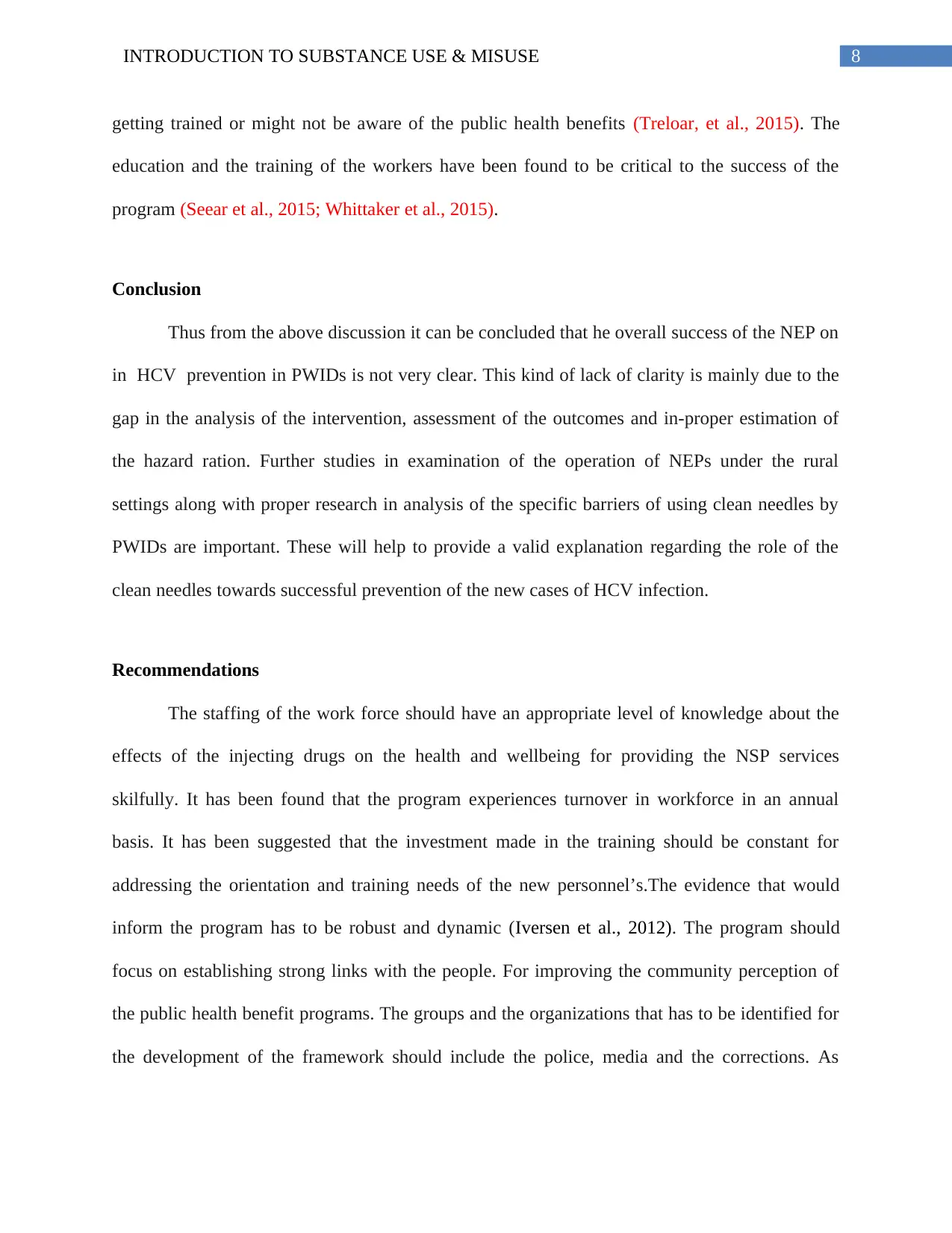
8INTRODUCTION TO SUBSTANCE USE & MISUSE
getting trained or might not be aware of the public health benefits (Treloar, et al., 2015). The
education and the training of the workers have been found to be critical to the success of the
program (Seear et al., 2015; Whittaker et al., 2015).
Conclusion
Thus from the above discussion it can be concluded that he overall success of the NEP on
in HCV prevention in PWIDs is not very clear. This kind of lack of clarity is mainly due to the
gap in the analysis of the intervention, assessment of the outcomes and in-proper estimation of
the hazard ration. Further studies in examination of the operation of NEPs under the rural
settings along with proper research in analysis of the specific barriers of using clean needles by
PWIDs are important. These will help to provide a valid explanation regarding the role of the
clean needles towards successful prevention of the new cases of HCV infection.
Recommendations
The staffing of the work force should have an appropriate level of knowledge about the
effects of the injecting drugs on the health and wellbeing for providing the NSP services
skilfully. It has been found that the program experiences turnover in workforce in an annual
basis. It has been suggested that the investment made in the training should be constant for
addressing the orientation and training needs of the new personnel’s.The evidence that would
inform the program has to be robust and dynamic (Iversen et al., 2012). The program should
focus on establishing strong links with the people. For improving the community perception of
the public health benefit programs. The groups and the organizations that has to be identified for
the development of the framework should include the police, media and the corrections. As
getting trained or might not be aware of the public health benefits (Treloar, et al., 2015). The
education and the training of the workers have been found to be critical to the success of the
program (Seear et al., 2015; Whittaker et al., 2015).
Conclusion
Thus from the above discussion it can be concluded that he overall success of the NEP on
in HCV prevention in PWIDs is not very clear. This kind of lack of clarity is mainly due to the
gap in the analysis of the intervention, assessment of the outcomes and in-proper estimation of
the hazard ration. Further studies in examination of the operation of NEPs under the rural
settings along with proper research in analysis of the specific barriers of using clean needles by
PWIDs are important. These will help to provide a valid explanation regarding the role of the
clean needles towards successful prevention of the new cases of HCV infection.
Recommendations
The staffing of the work force should have an appropriate level of knowledge about the
effects of the injecting drugs on the health and wellbeing for providing the NSP services
skilfully. It has been found that the program experiences turnover in workforce in an annual
basis. It has been suggested that the investment made in the training should be constant for
addressing the orientation and training needs of the new personnel’s.The evidence that would
inform the program has to be robust and dynamic (Iversen et al., 2012). The program should
focus on establishing strong links with the people. For improving the community perception of
the public health benefit programs. The groups and the organizations that has to be identified for
the development of the framework should include the police, media and the corrections. As
⊘ This is a preview!⊘
Do you want full access?
Subscribe today to unlock all pages.

Trusted by 1+ million students worldwide
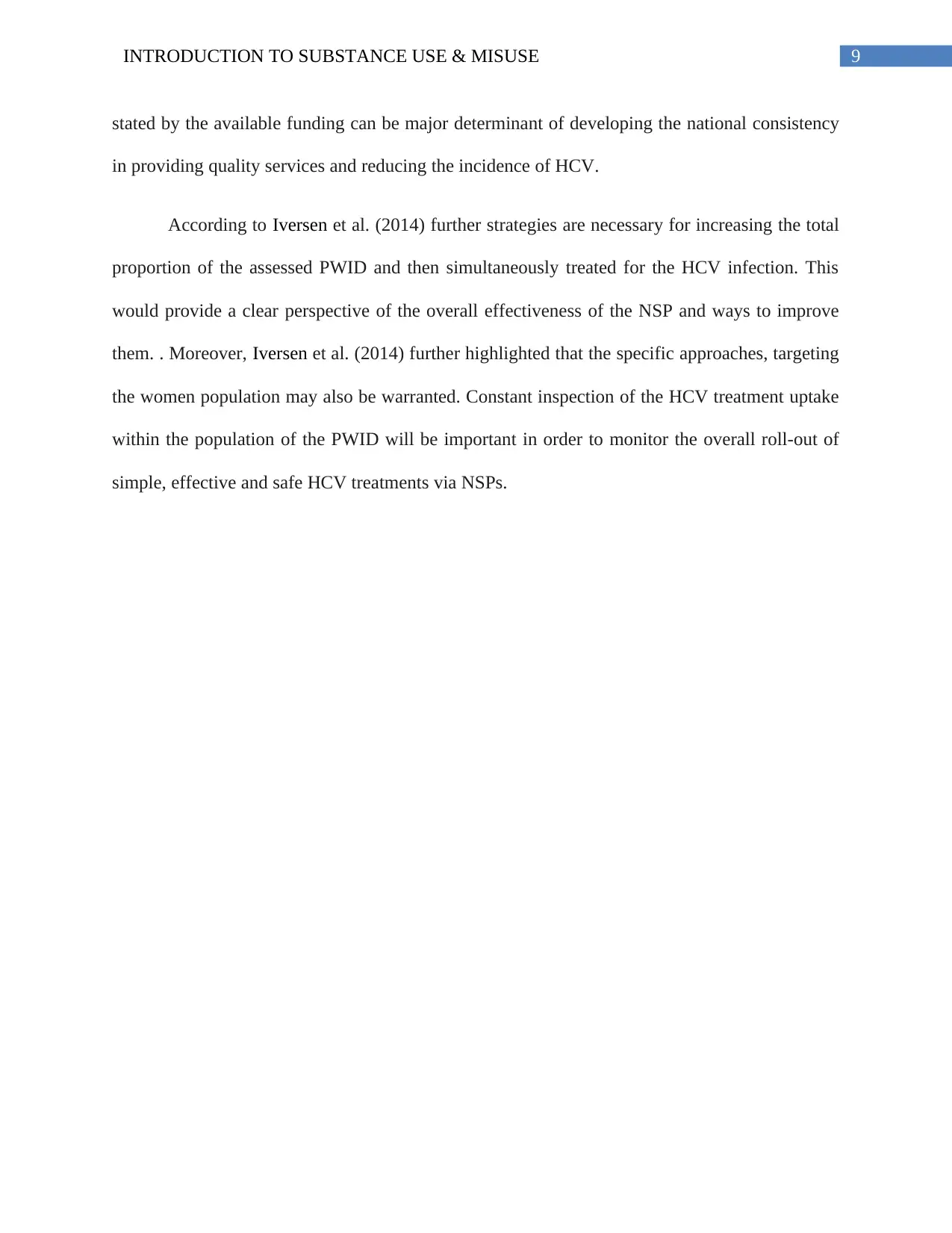
9INTRODUCTION TO SUBSTANCE USE & MISUSE
stated by the available funding can be major determinant of developing the national consistency
in providing quality services and reducing the incidence of HCV.
According to Iversen et al. (2014) further strategies are necessary for increasing the total
proportion of the assessed PWID and then simultaneously treated for the HCV infection. This
would provide a clear perspective of the overall effectiveness of the NSP and ways to improve
them. . Moreover, Iversen et al. (2014) further highlighted that the specific approaches, targeting
the women population may also be warranted. Constant inspection of the HCV treatment uptake
within the population of the PWID will be important in order to monitor the overall roll-out of
simple, effective and safe HCV treatments via NSPs.
stated by the available funding can be major determinant of developing the national consistency
in providing quality services and reducing the incidence of HCV.
According to Iversen et al. (2014) further strategies are necessary for increasing the total
proportion of the assessed PWID and then simultaneously treated for the HCV infection. This
would provide a clear perspective of the overall effectiveness of the NSP and ways to improve
them. . Moreover, Iversen et al. (2014) further highlighted that the specific approaches, targeting
the women population may also be warranted. Constant inspection of the HCV treatment uptake
within the population of the PWID will be important in order to monitor the overall roll-out of
simple, effective and safe HCV treatments via NSPs.
Paraphrase This Document
Need a fresh take? Get an instant paraphrase of this document with our AI Paraphraser
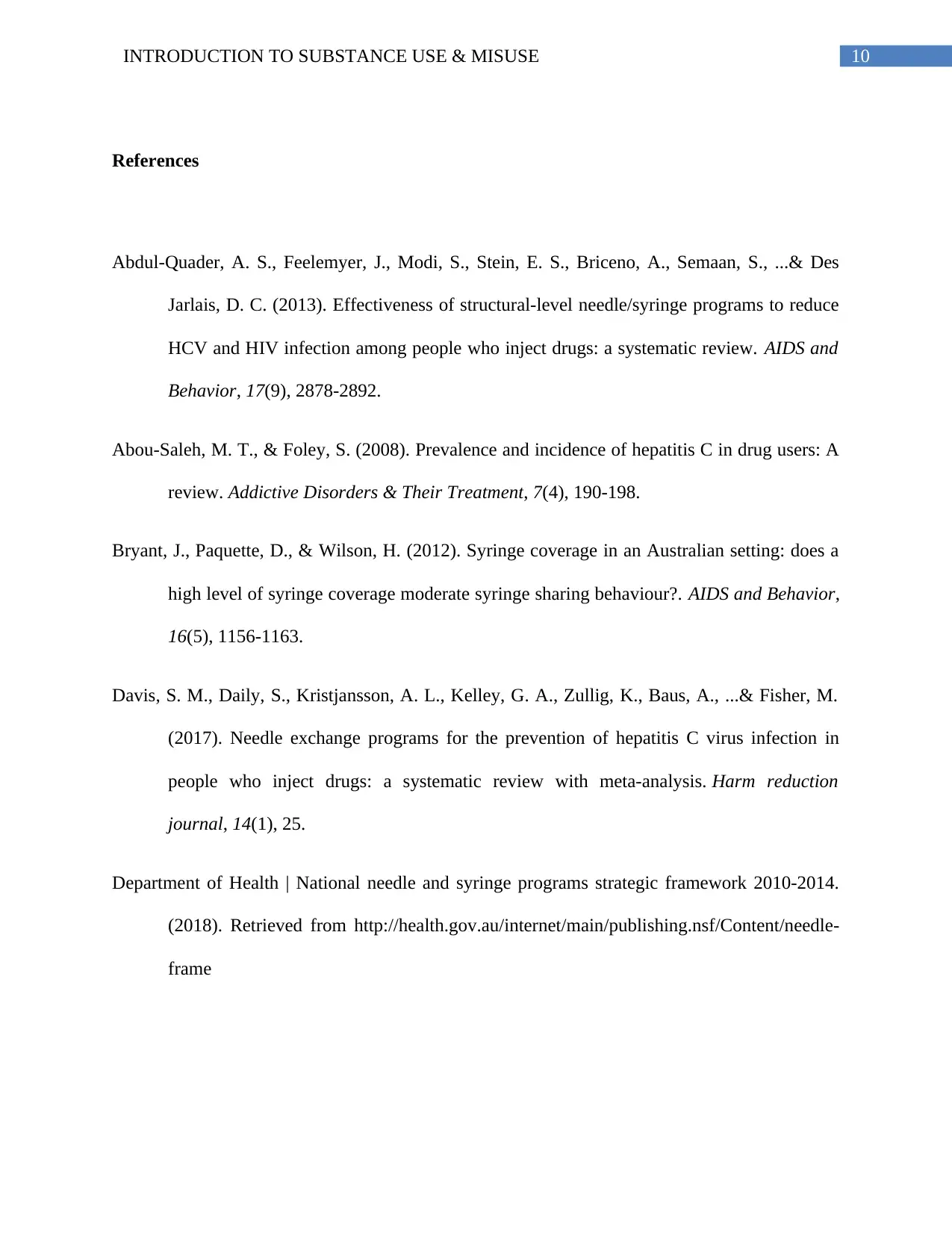
10INTRODUCTION TO SUBSTANCE USE & MISUSE
References
Abdul-Quader, A. S., Feelemyer, J., Modi, S., Stein, E. S., Briceno, A., Semaan, S., ...& Des
Jarlais, D. C. (2013). Effectiveness of structural-level needle/syringe programs to reduce
HCV and HIV infection among people who inject drugs: a systematic review. AIDS and
Behavior, 17(9), 2878-2892.
Abou-Saleh, M. T., & Foley, S. (2008). Prevalence and incidence of hepatitis C in drug users: A
review. Addictive Disorders & Their Treatment, 7(4), 190-198.
Bryant, J., Paquette, D., & Wilson, H. (2012). Syringe coverage in an Australian setting: does a
high level of syringe coverage moderate syringe sharing behaviour?. AIDS and Behavior,
16(5), 1156-1163.
Davis, S. M., Daily, S., Kristjansson, A. L., Kelley, G. A., Zullig, K., Baus, A., ...& Fisher, M.
(2017). Needle exchange programs for the prevention of hepatitis C virus infection in
people who inject drugs: a systematic review with meta-analysis. Harm reduction
journal, 14(1), 25.
Department of Health | National needle and syringe programs strategic framework 2010-2014.
(2018). Retrieved from http://health.gov.au/internet/main/publishing.nsf/Content/needle-
frame
References
Abdul-Quader, A. S., Feelemyer, J., Modi, S., Stein, E. S., Briceno, A., Semaan, S., ...& Des
Jarlais, D. C. (2013). Effectiveness of structural-level needle/syringe programs to reduce
HCV and HIV infection among people who inject drugs: a systematic review. AIDS and
Behavior, 17(9), 2878-2892.
Abou-Saleh, M. T., & Foley, S. (2008). Prevalence and incidence of hepatitis C in drug users: A
review. Addictive Disorders & Their Treatment, 7(4), 190-198.
Bryant, J., Paquette, D., & Wilson, H. (2012). Syringe coverage in an Australian setting: does a
high level of syringe coverage moderate syringe sharing behaviour?. AIDS and Behavior,
16(5), 1156-1163.
Davis, S. M., Daily, S., Kristjansson, A. L., Kelley, G. A., Zullig, K., Baus, A., ...& Fisher, M.
(2017). Needle exchange programs for the prevention of hepatitis C virus infection in
people who inject drugs: a systematic review with meta-analysis. Harm reduction
journal, 14(1), 25.
Department of Health | National needle and syringe programs strategic framework 2010-2014.
(2018). Retrieved from http://health.gov.au/internet/main/publishing.nsf/Content/needle-
frame
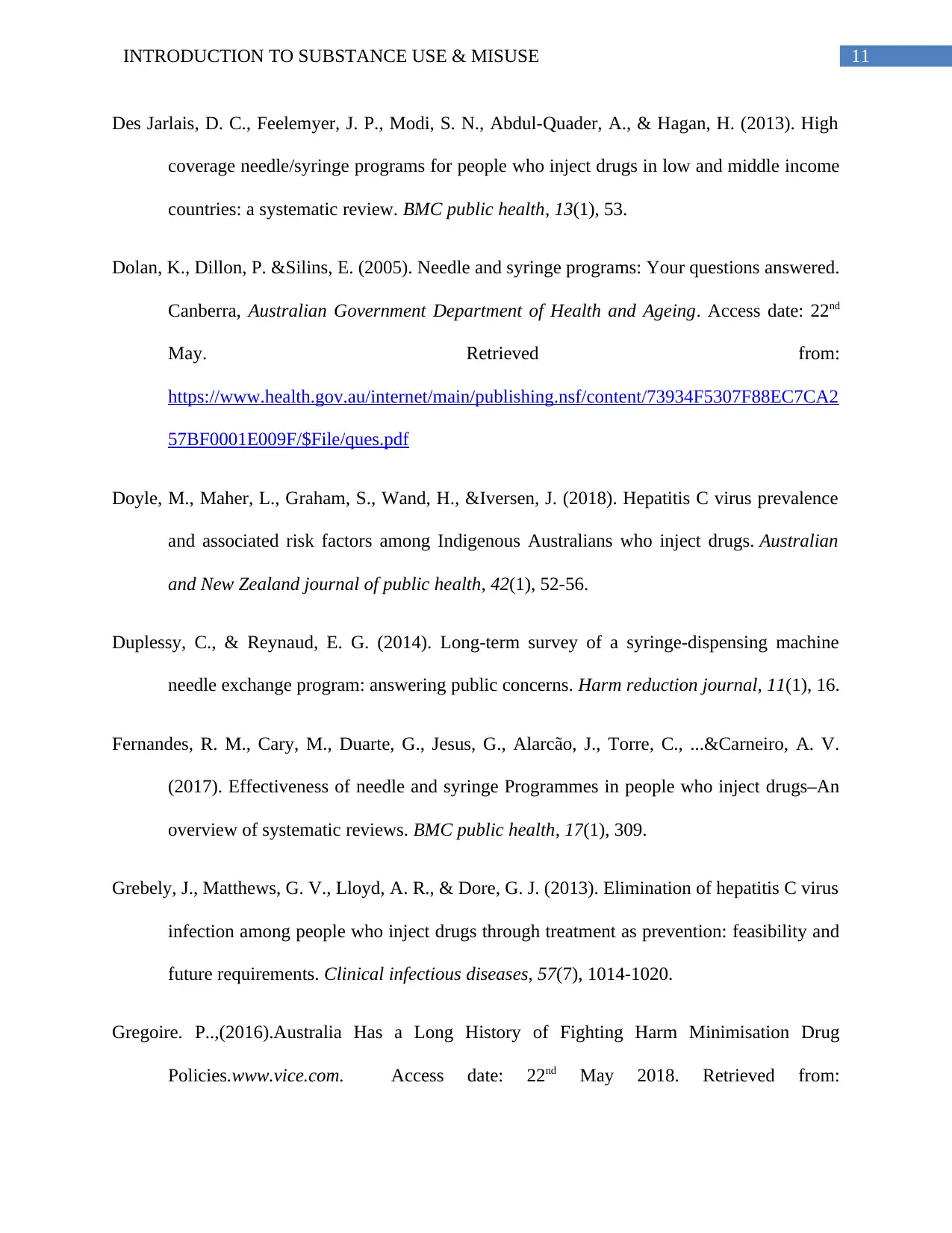
11INTRODUCTION TO SUBSTANCE USE & MISUSE
Des Jarlais, D. C., Feelemyer, J. P., Modi, S. N., Abdul-Quader, A., & Hagan, H. (2013). High
coverage needle/syringe programs for people who inject drugs in low and middle income
countries: a systematic review. BMC public health, 13(1), 53.
Dolan, K., Dillon, P. &Silins, E. (2005). Needle and syringe programs: Your questions answered.
Canberra, Australian Government Department of Health and Ageing. Access date: 22nd
May. Retrieved from:
https://www.health.gov.au/internet/main/publishing.nsf/content/73934F5307F88EC7CA2
57BF0001E009F/$File/ques.pdf
Doyle, M., Maher, L., Graham, S., Wand, H., &Iversen, J. (2018). Hepatitis C virus prevalence
and associated risk factors among Indigenous Australians who inject drugs. Australian
and New Zealand journal of public health, 42(1), 52-56.
Duplessy, C., & Reynaud, E. G. (2014). Long-term survey of a syringe-dispensing machine
needle exchange program: answering public concerns. Harm reduction journal, 11(1), 16.
Fernandes, R. M., Cary, M., Duarte, G., Jesus, G., Alarcão, J., Torre, C., ...&Carneiro, A. V.
(2017). Effectiveness of needle and syringe Programmes in people who inject drugs–An
overview of systematic reviews. BMC public health, 17(1), 309.
Grebely, J., Matthews, G. V., Lloyd, A. R., & Dore, G. J. (2013). Elimination of hepatitis C virus
infection among people who inject drugs through treatment as prevention: feasibility and
future requirements. Clinical infectious diseases, 57(7), 1014-1020.
Gregoire. P..,(2016).Australia Has a Long History of Fighting Harm Minimisation Drug
Policies.www.vice.com. Access date: 22nd May 2018. Retrieved from:
Des Jarlais, D. C., Feelemyer, J. P., Modi, S. N., Abdul-Quader, A., & Hagan, H. (2013). High
coverage needle/syringe programs for people who inject drugs in low and middle income
countries: a systematic review. BMC public health, 13(1), 53.
Dolan, K., Dillon, P. &Silins, E. (2005). Needle and syringe programs: Your questions answered.
Canberra, Australian Government Department of Health and Ageing. Access date: 22nd
May. Retrieved from:
https://www.health.gov.au/internet/main/publishing.nsf/content/73934F5307F88EC7CA2
57BF0001E009F/$File/ques.pdf
Doyle, M., Maher, L., Graham, S., Wand, H., &Iversen, J. (2018). Hepatitis C virus prevalence
and associated risk factors among Indigenous Australians who inject drugs. Australian
and New Zealand journal of public health, 42(1), 52-56.
Duplessy, C., & Reynaud, E. G. (2014). Long-term survey of a syringe-dispensing machine
needle exchange program: answering public concerns. Harm reduction journal, 11(1), 16.
Fernandes, R. M., Cary, M., Duarte, G., Jesus, G., Alarcão, J., Torre, C., ...&Carneiro, A. V.
(2017). Effectiveness of needle and syringe Programmes in people who inject drugs–An
overview of systematic reviews. BMC public health, 17(1), 309.
Grebely, J., Matthews, G. V., Lloyd, A. R., & Dore, G. J. (2013). Elimination of hepatitis C virus
infection among people who inject drugs through treatment as prevention: feasibility and
future requirements. Clinical infectious diseases, 57(7), 1014-1020.
Gregoire. P..,(2016).Australia Has a Long History of Fighting Harm Minimisation Drug
Policies.www.vice.com. Access date: 22nd May 2018. Retrieved from:
⊘ This is a preview!⊘
Do you want full access?
Subscribe today to unlock all pages.

Trusted by 1+ million students worldwide
1 out of 17
Related Documents
Your All-in-One AI-Powered Toolkit for Academic Success.
+13062052269
info@desklib.com
Available 24*7 on WhatsApp / Email
![[object Object]](/_next/static/media/star-bottom.7253800d.svg)
Unlock your academic potential
Copyright © 2020–2025 A2Z Services. All Rights Reserved. Developed and managed by ZUCOL.



